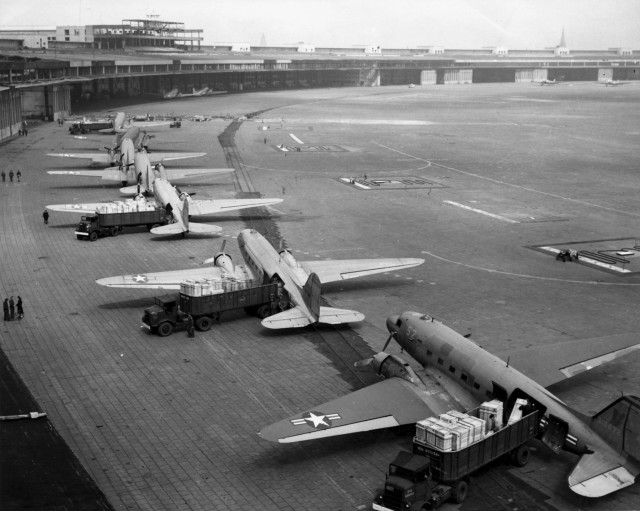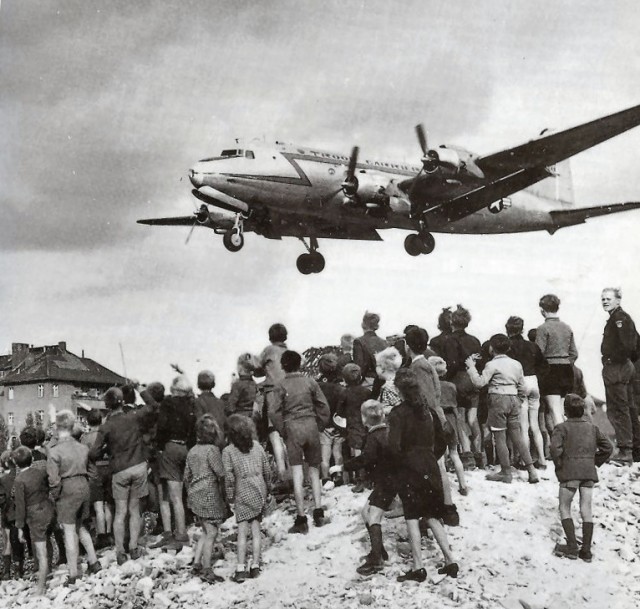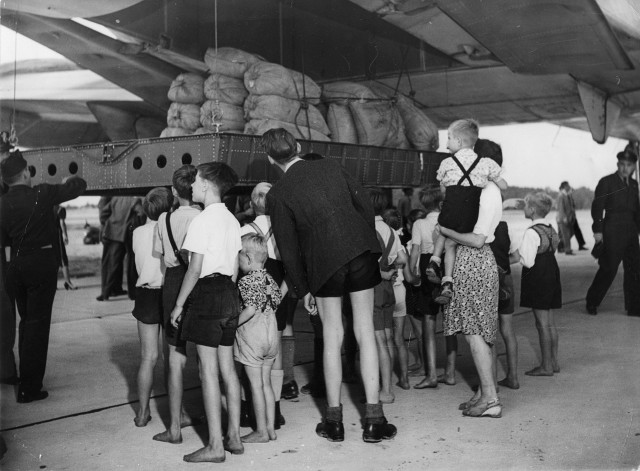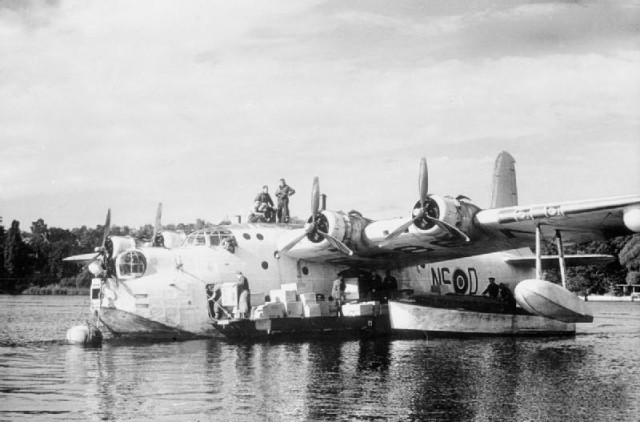June 25, 1948, the Soviet Union, flush with the success of driving the Nazis out of Russia, was becoming piqued at the US and British. Relations were rotten. The Soviet Communists had imported their dictatorial politics to East Germany and were losing the battle for the hearts and minds of the Germans. You see, the Germans had seen years of Allied generosity and a willingness to restore democratic freedoms that Hitler had removed since the 1930’s. Given a choice, the Germans were choosing the Western ideals.
The Soviets would have no part of it. Or should I say the Communists since the resistance to the West did not come from the Russian people, it came from the Communist Party which saw the clash in Berlin as a PR disaster in the making.
Soon the Communists decided that they were simply going to elbow the Americans French and the British out of Berlin altogether. ‘The transport division of the Soviet military administration is ordered to halt all passenger and freight traffic to and from Berlin tomorrow at 0600 hours because of technical difficulties. West Berlin will receive electricity only between 11 p.m. and 1 a.m….’
It escalated to April 1st, 1948, when U.S. authorities had refused to submit to Soviet inspection of military rail shipments. A fight was avoided by negotiations. But a passive aggressive stance became the tactic of the day when on June 15th, Communist forces shut down the autobahn. Their claim was that it needed repairs.

Although Douglas C-47 Skytrains from the 60th and 61st Troop Carrier Groups at Kaufbeuren and Rhein Main were flying trips daily West Berlin and Royal Air Force were also flying daily trips, it was on June 26th that the so-called Berlin Airlift officially commenced.
The East Berlin authorities banned all land river and rail service to re-supply the Eastern portion of the city. The Allied occupational forces had managed to keep three 20-mile-wide air corridors into East Germany open. Give someone an inch, they’ll take a mile. In this case it was three airstrips, and the amount of tonnage flown in this effort is to this day still nothing short of phenomenal.
One of the biggest games of chicken between the US and Russia began here. The Communists made a few miscalculations. First, they thought they would win the cooperation of the East Germans by punishing them with an embargo. Then they thought that we would stand by idly while they acted just like the dictator everyone had just been subjected to. Finally they misjudged the airlift capacity of the Allied forces and the will to implement the plan. It was called “Operation Vittles”.
General Lucius D. Clay was the highest ranking American officer in West Germany contacted called Lt. Gen. Curtis E. LeMay, the commander of the U.S. Air Force in Europe.

General LeMay’s staff calculated what a re supply mission of this sort would require with the aircraft available in the theater. The 2,000 tons of coal and 1,439 tons of food per day to for 2 million inhabitants was not possible with the C-47s sitting around.
Berlin’s Lord Mayor-Elect Ernst was ready to capitulate, but was talked out of it by Americans who basically said “have a little faith.”
All C-47s in Western Europe were ordered to stage into Wiesbaden and Frankfurt, where two large American bases sat near the East German border.
Also four-engine Douglas C-54 Gooney Bird transports that could carry 10 tons each were ordered from Central America, the Pacific theatre, Alaska, and continental United States. Ground crews, mostly out of work German civilians loaded supplies. The RAF offered 58 Douglas C-47 Dakotas, a few Handley Page Hastings and 40 Avro York aircraft. They used Gatow in the British sector as a base of operations.
Within days, a C-47 was landing at Tempelhof every eight minutes; well over 150 planeloads a day, but it was a fraction of what was needed. Berliners were already beginning to dig into their pantries.
A classic propaganda war ensued and this one the Soviet press could not win. The evil Communists try and starve their unwilling constituents and the west comes to the rescue. Templhof airbase in East Berlin had become ground zero in the beginning of the Cold War. It had gone from winding down to one or two flights a day to constant air traffic in and out. Reporters from the west and the east milled about watching what the Germans were calling die Luftbrücke, or air bridge.
Inside West Germany technically skilled Russians, engineers, and equipment operators were forcibly deported to areas of need in Russia. Did they think that after the suffering of the previous years there wouldn’t be a network of people to leak this information? These people had been silently resisting for so long that it was in their blood to stand up against tyranny.
Did they think the neighbors of the Germans who were forcibly relocated would sit by and do nothing? Stalin was a one trick pony: he screwed everyone before they could screw him. Stalin thought that the tactics he used to shove competitors out of the way in post Tsarist Russia would work in a post WWII multi-national alliance. He thought he could force the Allies out of Germany and he wanted a united German capital thriving under Communist rule, and eventually a united Germany under his thumb.

There is a psychology behind his instincts. The Germans went after Stalingrad because it was his namesake. He would try and turn the tables on Hitler and end up ruling all of Germany instead.
Only one thing stood in his way: US and Allied airlift capability.
In August, Allies lifted 121,000 tons and West Berliners were gradually getting enough to live on comfortably. Seeing that two airfields could not carry the load, a new airfield Tegel, was steamrolled in the French sector. The steamrollers had to be cut into sections and re-assembled in East Berlin because they were too large for the C-54s.
Eventually veteran Maj. Gen. William H. Tunner, a World War II who organized the re-supply operations from India to China was called on. Soon he was named commander of the Combined Airlift Task Force. The first thing he did was schedule regular heavy maintenance. Engines were maintained by the Navy machine shops at Alameda Naval Air Station, California.
The bitter winter weather also strained operations. Icing was a huge problem because the volume of the supplies allowed little time for maintenance on runways.
Tunner said in an interview ‘What I found was badly needed was better timing of the flying operation….Valuable time was wasted in Berlin as crews landed, parked, shut off engines, took off for the snack bar and then strolled over to Operations to make out their return clearances. I laid down an order: No crew member was to leave the side of his aircraft while the Germans unloaded it.
Each plane would be met by an operations officer who would hand the pilot his return clearance all filled out, and a weather officer would give him the latest weather back at his home base. Mobile snack bars tended by ladies in Berlin would move to the side of each plane. Turn-around time was cut in half to 30 minutes.’
Tunner’s changes made the flights much more efficient. He forced crews to make instrument landings to avoid delays due to the weather. Plus the total route was 120 miles often through bad weather. Most of the Air Force pilots were 30 to 60 days away from home. They were mostly part time and reserve force pilots.
‘Things like poor mail service, no curtains on the windows so crews could sleep in the daytime, and poor washing facilities took on huge proportions,’ Tunner said. He created a competition and published loading times to see if he could motivate crews to outperform each other. Remember people were still exhausted from the clean up of central Germany after the war. It’s not like there wasn’t a ton to do around air fields of a country that is trying to rebuild itself. In 1949 a 12-man crew C-54 loading crew loaded 20,000 pounds in five minutes and 45 seconds.
There was a shortage of trained aircraft maintenance people and crews trained for a rigorous full load take-offs day and night. At Great Falls Air Force Base in Montana, replacement pilots were trained. The narrow air corridors, the approach to the three bases inside West Germany, and the instrument landings were duplicated exactly for practice. C-54s were loaded with 64,000 pounds of sand for practice flights, and flying these re-supply missions was so strenuous and exacting that three landings were required at 70,000 pounds before a pilot qualified.

By the end of September the Dakotas were taken off line and 225 C-54s were doing the hard work. An East German spy, stationed in an apartment house and noting the unloading of every plane at Tempelhof, was reportedly punished by authorities who thought he was just making up the tonnage totals.
Few realize how close this came to becoming a shooting war. American P-80 Shooting Stars and P-47 Thunderbolt aircraft flew escort and combat air patrols. A Soviet anti-aircraft artillery unit moved in front of the RAF field at Gatow and fired incendiary bullets at British aircraft in and around Gatow. Over 700 times Soviets made aggressive movements towards aircraft during Operation Vittles. These included dropping fake bombs, releasing barrage balloons, live firing at and near aircraft and jamming radio signals.
The airlift didn’t actually end until September 30, 1948. Total flights: 276,926, total passengers, 227,655 ; Total days of operation, 321; total supply tonnage 2,323,067; total taxpayer costs to Americans, $345 million, to the Brits, 17 million pounds; to the Germans, 150 million Deutschmarks; total lives: Seventy-five American and British.
By the Spring of 1949, it became obvious to the Russians that not only was the plan going to work, The Airlift was now flying in more tonnage per day than they were previously sending in by rail. During a 90 day period in 1948, the total tonnage of all US 18 domestic carriers including mail and cargo and passengers amounted to 3,119 tons. That was less than the amount of cargo carried into Berlin in one day at the operational zenith.
It was the first major loss in the Cold War for the Soviets. They had miscalculated. They couldn’t imagine the will of the Americans and British and French to spend all this time and effort just to make a point.
On May 12th, 1949, the Soviets blinked.
Sources and Citations:
- Giangreco, D. M.; Griffin, Robert E. (1988). Airbridge to Berlin : The Berlin Crisis of 1948, Its Origins and Aftermath
- Over the Hump, by William H. Tunner; and Bridge in the Sky: The Story of the Berlin Airlift, by Frank Donovan.
- Cherny A. 2008. The Candy Bombers: The Untold Story of the Berlin Airlift and America’s Finest Hour. G.P. Putnam’s Sons, New York.
- A Special Study Of Operation Vittles: The Story Of The Berlin Airlift, 2007. Kessinger Publishing
- Miller, Roger G. (1998), To Save a City: The Berlin Airlift, 1948–1949, US Government printing office, 1998–433–155/92107, (132 pages)
Originally published at civilianmilitaryintelligencegroup.com on May 31, 2009. / By Daniel Russ
